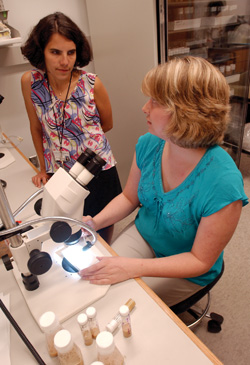
Daniela Drummond-Barbosa, Ph.D., left, and Leesa LaFever, a research assistant, collaborated on the paper published in Science.
photo by Dana Johnson
Insulin ‘eggs on’ stem cell proliferation: study
Tissue stem cells, the parent cells that give rise to all cell types in a tissue, require a certain amount of coddling to continue producing new adult cells.
In the Aug. 12 issue of Science, Vanderbilt University Medical Center researchers describe how nutrition-controlled factors like insulin influence stem cell behavior in fruit fly ovaries, providing insight that could have important implications for stem cell research as well as human reproduction.
“We are interested in a general biological question — how are adult tissues that are maintained by stem cells regulated by nutrition?” explained Daniela Drummond-Barbosa, Ph.D., assistant professor of Cell and Developmental Biology and senior author on the study.
The ovary of the fruit fly Drosophila provides an ideal model system for addressing this question. Unlike human ovaries, which are thought to generate a lifetime supply of eggs before birth, the fly ovary continually produces new eggs throughout adulthood. The new eggs are made from scratch by stem cells that reside in the fly ovary.
“We knew that the ovary responded to nutrition because flies on rich food would lay lots of eggs, but on poor food, they hardly laid any eggs,” Drummond-Barbosa said.
Previously, she had found that the response of the ovary to nutrition was in part due to the effect of insulin on the germline stem cells, the ovarian stem cells that divide to produce the egg and its supporting cells.
Insulin is the hormone that regulates the metabolism of fats and sugars. In humans, the pancreas produces insulin when blood glucose levels increase after eating. In flies, insulin-like proteins (called DILPs) are primarily produced by a discrete set of brain cells, but a small amount is also made by follicle cells that surround nearly mature eggs.
“I showed that the stem cells change their rate of division in response to nutrition, dividing faster on a rich food and more slowly on a poor food, and that insulin is required for this response,” she said.
But those studies did not reveal how insulin influences ovarian stem cells. Because scientists knew that neighboring cells send out chemical signals that control stem cell proliferation, it was assumed that insulin acts indirectly via these neighboring cells, not directly on the stem cell.
“When we found that insulin was controlling the ovarian response, we wanted to understand how — where was the insulin coming from, which cells are responding directly to insulin, and which are responding indirectly?”
In the current study, Drummond-Barbosa and Leesa LaFever, her research assistant, addressed these questions by looking in more detail at how insulin signaling controls different aspects of egg development.
First, the researchers killed the brain cells that make insulin and examined the ovary's response.
They found that female flies without the insulin-producing brain cells did not show the increase in ovarian cell proliferation and egg production seen in normal female flies given a protein-rich diet.
“This shows that the brain insulin-producing cells are the major source of insulin signals controlling the ovary.”
Next, they created genetically altered flies that had a combination of normal cells and cells lacking the insulin receptor.
They found that germline stem cells lacking the receptor (and therefore, unable to respond to insulin) divided more slowly than normal stem cells. In addition, the stem cell-derived germline cysts (a ball of 16 cells that includes one immature egg and 15 support cells) lacking this receptor had the correct number of cells and looked normal, but lagged far behind in growth rate compared to normal cysts.
These results demonstrate that neural-derived insulin directly impacts the rate at which ovarian stem cells divide and germline cysts grow, contrary to the previous assumption of an indirect role.
The findings may have implications beyond the ovary.
“In the same way that insulin is directly controlling the rate of stem cell division in the fly ovary, it must be controlling the rate of stem cell division in other tissues as well,” Drummond-Barbosa said. Since tissues like the skin are continually renewed by stem cell division, insulin and nutrition likely have an important role in cell proliferation during wound healing.
Although it is unclear whether human ovaries contain similar stem cells, insulin and other nutritional factors are known to play important roles in human fertility and reproduction.
“Nutrition affects reproduction, by supporting the development of the fetus and also by regulating ovulation,” she said. “Women who are either severely starved or obese or who have insulin signaling problems (diabetes) often fail to ovulate. So there is a definite relationship between nutritional status and reproduction in mammals.”
“Knowing whether insulin has a direct or indirect role in mammalian stem cell regulation or in ovarian function could change the way we think about a variety of therapeutic strategies.”













